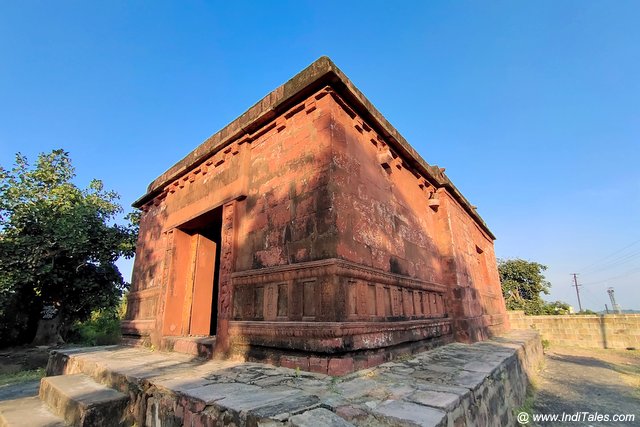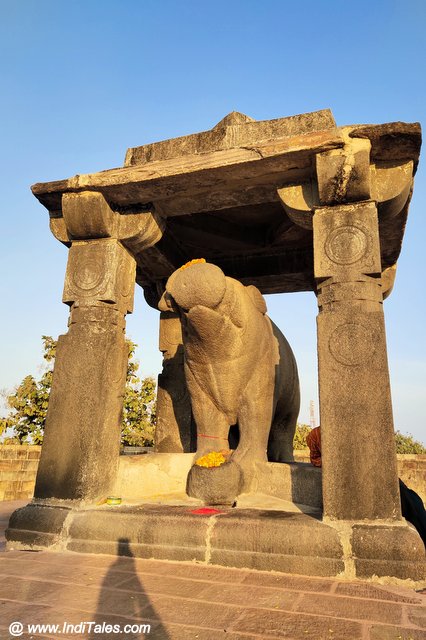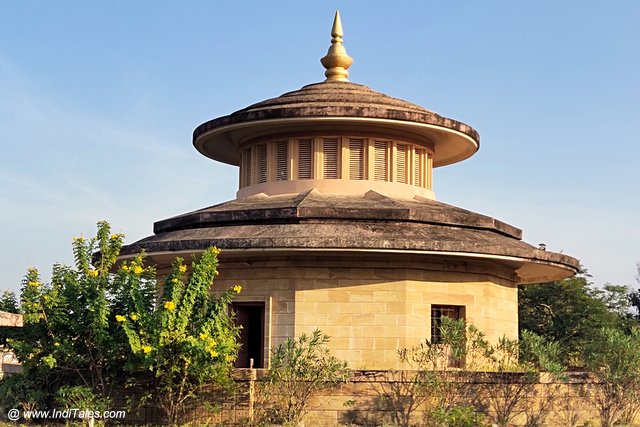Ramtek near Nagpur in the Vidarbha region of Maharashtra is rooted in history from multiple eras.
Ramayana and Ramtek
It gets its name from Sri Ram of Ayodhya, who took a Tek or a Vow here to rid the earth of Asuras. It can also mean the place where he rested for a while during his southward journey. Earlier this hill was called Tapogiri, which literally means the hill of Tapas or the place where a lot of sages perform Tapas.
Agastya Muni Ashram
You may think why only this place? Well, this is where Agastya Muni had an ashram and Sri Ram visited him during his 14-year exile. We know from Ramayana that during his journey through the forests of India, he killed many asuras. This relieved many sages and saints who used to have their ashrams in the deep forests.
Dandakaranya of which Ramtek is a part was a dense forest. Asuras living here would not let the sages live in peace. So, when Sri Ram visited Agastya Muni, he vowed to get rid of these Asuras who were killing many rishis. He also performs the last rites or tarpana of the rishis killed by Asuras by inviting all the Tirthas of India to Ambakunda Bhogawati which is now known as Ambala Talav.
Lopamudra, the wife of Agastya Muni was the daughter of the king of Vidarbha which lies just east of Ramtek.
Agastya Muni requested Sri Ram, Sita, and Lakshman to stay on the Tapogiri hill in the form of Jyoti or light. A flame that can still be seen in the Agastya Muni Ashram is believed to be their form that has been burning since Treta Yuga.
Second Visit of Sri Ram
Sri Ram returned to Ramtek after he became the king of Ayodhya. The story goes that during Ram Rajya, no younger person died before his elders. However, one day a man came to his court carrying the dead body of his son. The reason was Shambuka who was doing Tapasya close to Ramtek. Sri Ram traveled again to Ramtek to release Shambuka.
As a boon, Shambuka asked him to stay in his royal avatar on the hill along with Sita ji and Lakshman. He obliged. During this trip, Hanuman ji also accompanied him and held his Bow while he tackled Shambuka only with his arrow. So, here is a temple with Hanuman holding the bow, probably the only place where he does so.
Temples at Ramtek Hill
Ramtek temple is popularly known as Gadh Mandir or the fort temple. It is indeed built like a fort on top of a hill, from where you can see all around. As you go up you pass through gates that resemble the fort gates. Was it replicating Ayodhya here – maybe!
History of Ramtek
Historically, I am told the place had only Ram Padukas to mark the footprints of Sri Ram and Agastya Ashram. The Yadava rulers built the temple during 12-14th CE. The present temple was built by Raghu ji Bhosle of Nagpur in the 18th CE. The story goes that Raghuji Bhosle had vowed to build a temple here after winning the battle of Deogarh.

He had the Murtis of three deities made in Jaipur. However, he had a dream that the Murtis are lying in the Soor river. They did indeed find ancient Murtis there and the same was installed in the temple. The ones that came from Jaipur are still a part of temple assets.
Raghuji Bhosle also got the fortification done around the temple. It was the time when invasions of temples were common, so no wonder fortification was needed.
Built-in stone, it follows the local Hemadpanti style, with a tall Shikhara and pillared mandapa.
Gadh Mandir
The main temple complex at the top of the hill has many big and small temples.

You enter through the profusely carved Gokuldwar with a huge bell and ornate stone pillars. You first see the Agastya Ashram. The story of the place is written on a white wall in red letters.

Inside this ashram, the most important part is the Akhand Jyoti, or the eternal flame that is believed be to burning since the time Sri Ram visited Ramtek. A Radha Krishna temple is also here, I believe built much later.

Then, you see the temple dedicated to Lakshman. He is usually seen together with Sri Ram and Sita, but here his temple stands in front of their temple, almost as if he is still guarding them in Dandakaranya.

Behind his temple is the main temple dedicated to Sita Ram. It is a small but beautiful temple with a circular mandapa leading to the Garbhagriha.
In front, there is a Hanuman temple and a smaller Garuda temple.
After Pushkar, it is the second place where I found an Ekadashi Mata Mandir.
Trivikram Temple
This is an ancient temple located close to the parking of the hill. You have to hike a bit through an unpaved path to reach this temple. It is just an open-air pavilion with a staircase leading to it.

An ancient Murti of Vishnu as Trivikram stands on an open platform. It is broken in many places but you can still make out that the right leg of the figure is raised. At first glance, it feels like a figure in Terracotta. However, it is the red-colored sandstone found locally and I saw it at many temples in and around Nagpur.
These temples are dated back to the early 5th CE making them some of the oldest temples in India.
Sindoor Bavadi
This is a huge stepwell located right where you park your vehicles. There is a pillared pavilion on one side of the Sindoor Bavadi. It probably gets its name from the Sindoori or rust-red color of the stone found here. I was also told that one of the names of the hill is also Sindoorgiri.
Ugra Narsimha Temple

It is another small temple in red sandstone, with stone pillars inside. It has a giant-sized Ugra Narsimha Murti almost filling the Garbhgriha. There is a small mandapa in the front.
There may have been other deities on either side of this Murti but there is no way to know
Keval Narasimha Temple
This is a small temple complex with beautiful carvings on the outer walls. Doorjamb at the entrance has the different avatars of Vishnu carved. The temple is on a higher platform with a Narasimha Murti that is almost two meters high. The mandapa in front has four stone-carved pillars.

Close to this temple is a Naga temple in the open air with a huge Trishul next to it.
Another small temple, which would typically be a vahana temple, has a similar Murti of Narasimha that is covered in Sindoor, making people believe that it is a Hanuman Murti.
Varaha Temple
Halfway on your way to the Gadh Mandir, you find a small temple on large open premises. On the platform with four pillars is a giant Murti of Varaha.

Popular belief is that only virtuous people can pass beneath the belly of the Varaha.
Festivals at GadhMandir Ramtek
Ram Navami is obviously a big festival at this temple.
Another important festival happens on the Kartik Chaturdashi, a day before Kartik Purnima when Kartik Utsav is going on here. On this day Tulsi is offered to Shiva and Bilva leaves are offered to Sri Ram, in a unique exchange that brings out the oneness between them.
Kalidasa and Ramtek
Kalidasa – the poet in the court of Vikramaditya of Ujjain was sent here as his daughter of was married in Vidarbha. On this hill, he wrote his famous doot kavya or the messenger poetry called Meghdoota. The poem mentions the hill in its very first verse.

A newly built Kalidasa Samarak or memorial commemorates Kalidasa and Meghdoota. Built-in the shape of Om, it has a hall with paintings depicting the famous works of Kalidasa. There is an open-air theatre. The walls around it are painted with scenes from the Poem Meghdoota. The outer walls have all the verses of Meghdoota engraved on them.
It could have been a great tribute to the poet if only the place was maintained and alive. It is one of the filthiest places I have seen with grass growing and garbage everywhere. What is the point in celebrating a poet in stone if his works cannot be seen either in a bookshop or a drama or a feature film? Hope Maharashtra Tourism takes note and works on making it a living space.
There are enough tourists coming to Ramtek, and a good ambiance, restaurant, or learning activities would add to their experience.
Kapoor Bavadi
Karpoor or Kapoor Bavadi is located at the base of the hill. It is an ancient stepwell located next to a temple. The temple is crumbling and visitors hardly seem to care. I saw people climbing on the Shikhara with their footwear.

I could not visit the temple as the water level in the stepwell was too high. Bawadi was full of lotus flowers. Water Chestnut farming is common in ponds here. This is done along with lotus flowers that are used to offer at various temples.
One person told me the temple is dedicated to Shiva called Karpureshwar, while the other said it is dedicated to Saptamatrikas. I would not be surprised if all of them are present here as I can clearly see three distinct temple Shikharas indicating at least 3 temples.
There may have been more smaller temples in the three-sided corridor running around the stepwell. In the broken parts of Amalaka, which sits on top of Shikhara, some Murtis are just lying here and there.
I hope ASI steps in to conserve this temple as it can attract many more tourists and pilgrims. It is a lovely stepwell.
Ancient Shantinath Jain Temple is located close to Karpoor Bavadi, but I could not visit it.
You can visit Ramsagar Backwaters for some fun adventure activities like Kayaking.
Travel Tips
Ramtek is about 50 kilometers from Nagpur, making it well connected via Air, Rail, and Road.
You need at least 2-3 hours to visit this place. History enthusiasts can spend a day or two exploring many ancient heritage sites here.
You can take 700-odd steps to climb the hill or take your car to the foothill. There are about 150 steps that you need to climb from the parking.
There are ample shops to buy food, flowers, or souvenirs from the parking until the temple entrance.
Photography is allowed outside the main temple and is prohibited inside.
There are many monkeys on the hill, so be aware if you are carrying any food items.
